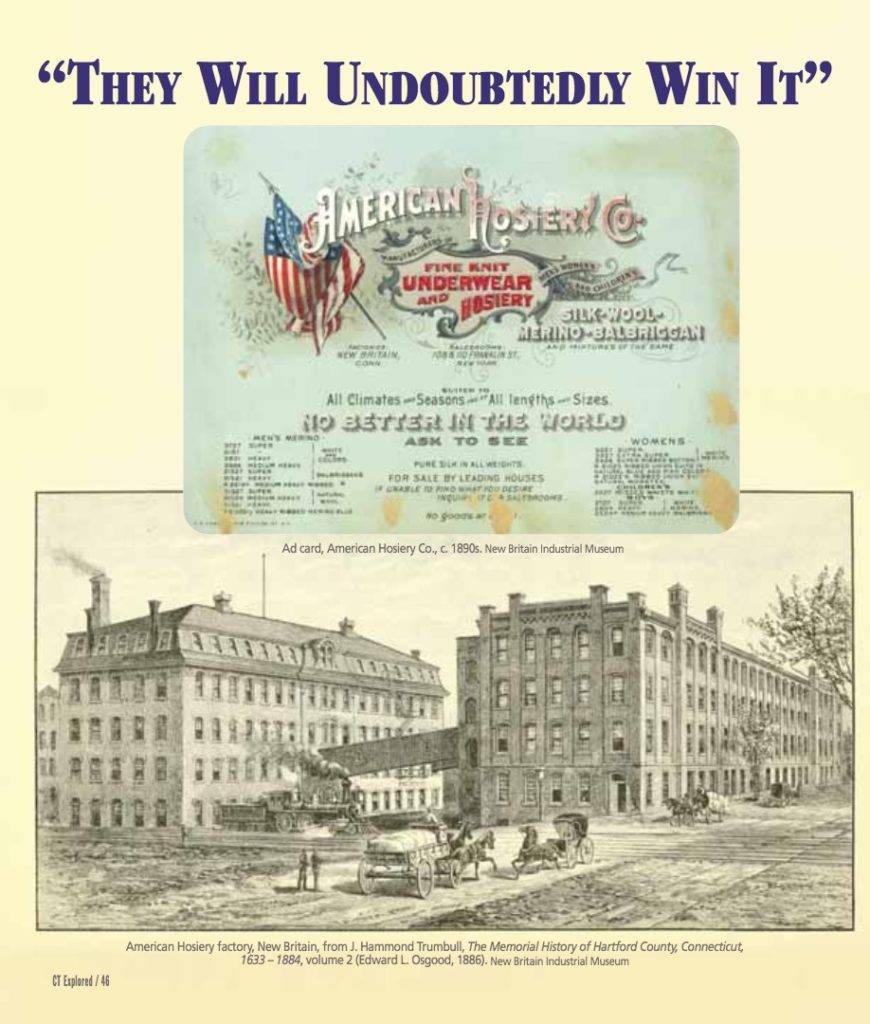(c) Connecticut Explored Inc. Winter 2019-2020
Subscribe/Buy the Issue!
A strike at the American Hosiery Company in 1886 lasted 47 days, included roughly 800 employees, and was organized by a committee of 50 children. It was one of six strikes against New Britain companies within a two-week span in February 1886—and one of two led by children.
Frustratingly, local newspaper coverage is all I’ve been able to find about what happened. The other child-led strike, at New Britain Knitting Company, was called over abuse, according to Hartford’s labor newspaper, The Examiner (February 13, 1886). The overseer there was accused of speaking to the young girls under his employ in the “vilest epithets” and treating the boys “roughly.” The paper reported one young boy had fallen unconscious after being struck by this boss.
The children at the American Hosiery Company did not cite abuse, The Examiner reported. They struck for a 10 percent raise. Twenty boys and girls from the mule room (where children spun cotton and other fibers) and 30 carders (responsible for separating fibers and reassembling them into a loose strand) started the strike. The Examiner noted, “it was really amusing to see the gravity with which these little ones none of whom are over 15 years of age manage their strike. They will undoubtedly win it.”
Three weeks later The Examiner reported that the Central Labor League intervened at New Britain Knitting Company. That strike was resolved within two weeks.
By March, though, the strike at American Hosiery had spread to other departments. Missouri’s Iron County Register reported on March 18, 1886 that “Nearly eight hundred employees of the American Hosiery Company, at New Britain, Conn., are out on a strike, their demand for higher wages having been refused. The company’s officers refused to meet a committee of the Knights of Labor to effect a settlement by arbitration.”
The local New Britain Herald provided plenty of coverage, publishing opposing views from company executive Edward H. Davison and Knights of Labor District Master Workman Thomas H. Kehoe on its editorial pages. But what is most interesting is that the striking children themselves managed to get two letters published there. In addition to clarifying their demands in this first letter on March 20, 1886, they explained a miscommunication between the company and the strikers’ committee:
A short time ago we saw an item in your paper to the effect that the rumor … that the company sent for our committee, was without foundation. That rumor was not so devoid of truth as your contradiction would imply. Our committee was informed by a gentleman who is in the confidence of the company […] that the company desired to meet them (sic). He did not say that he was authorized to tell our committee that the company expressed a wish to confer with them; but speaking for himself he advised the committee to go to the factory office, where he thought a representative of the company would be ready to confer with them. …We do not desire to make defiant utterances. But we have decided to adhere to the course we have resolved on, relying on the justice of our cause [to]succeed.
The Examiner published this on the same day:
The company have (sic) sent for and sounded the committee of the strikers lately but did not find the weaknesses they expected. The girls are determined to win and the members of labor organizations here in their individual capacity are determined they shall win. The men at the head of this concern are as mean and small as can be found anywhere on earth if the stories told by parties who have worked for them can be believed. They have fatted off the flesh and bones of their wage slaves for years and they don’t like the idea of being disturbed in their feast at all. They cherish no love for labor organizations and have an idea they can break them down by keeping out their help for awhile. Probably they will find out their mistake.
After a series of letters between Davison and Kehoe, the striking children’s second letter appeared in the New Britain Herald on March 24, 1886.
The company say (sic) that they have made concessions to us. We are at a loss to know how they have conceded an iota of our demands. We would thank them to enlighten the public on this point, as we frankly acknowledge our inability to do so.
The strike settled one week later. According to the New Britain Herald on March 31, 1886, the whole conflict was the result of a misunderstanding between the company and the strikers. The company, the paper reported, had been willing to pay the 10 percent raise all along. After one massive misunderstanding, the Herald reported, “The girls resume work Monday next.”
Sophie Huget is executive director of the New Britain Industrial Museum.

